In The Garden: Creating Support For Your Vegetable Plants
- Pat's Bean Tee Pee
- Gourd Plant In Tree
- Beans On Both Sides of Fence
- Chain Link and Woven Top
- Woven for Cucumbers
- Gourds and Beans Growing On Both Sides of Fence
- Cucumbers On Fence
In the garden it is important to create support for your climbing vegetable plants. Pole beans, cucumbers, squash, and tomatoes benefit from good support systems. In the case of tomatoes, and for our region specifically, a tomato support system should be designed to also support coverings like tarps or sheets, in case of a frost or freeze.
For supports the sky is the limit, and there are just a few rules. First it is important to make a support that is strong. You do not want your trellis to come crashing down with the weight of your ripening vegetables in the middle of your growing season. Next, be sure that you whatever you make for support doesn’t hinder harvests. If you are using chain link fencing for support then you should be able to get to both sides of the fence easily, because you can bet your beans will. If you are building a support system for tomatoes you should be able to reach through it with a 2lb tomato in your hand (Imagine a soft ball.), because you may have to! If you are using lumber use untreated lumber.
The last rule is first use what you’ve got, or can find. Most of us have surplus stuff around the yard or farm that can be used in a vine support system. This is one of the ways to stretch your budget and your creative powers to make something recycled, green and distinctly your own. I use hay bailing string hung from the fence to entice bean seedlings to find the fence. I use a lot of bamboo because it is growing on my property. It is strong, sustainable, and easy enough to work with. I drill holes in it and wire it or zip tie it to other bamboo pieces, or I drill holes in it and screw it to lumber supports, and I tie bamboo tripods and quadpods together at the top with sisal string, and for tomatoes I run long bamboo horizontally across the junctions of the tripods at their tops so that I can hang an electric light between the tomato plants when I cover them up for a hard freeze.
If you decide to weave your own support it is a good idea to use sisal or hemp ropes and strings because they are biodegradable. That way at the end of the crop or season you can cut it all down together and chuck it into the compost.
It is pretty easy to find sisal ropes and strings. I most recently bought some at Lowes. I wouldn’t be surprised if Tractor Supply, and Home Depot have sisal too.
If you have long pieces of rebar laying around the garden you might hoop the rebar over the garden and tie strings down to pole bean or squash seedlings from various points on the hoop’s arch. You will need to sink some fence post type lumber on each side to support the rebar. You can attach the rebar to the posts with hardware, or my own favorite zip ties.
There are myriad ways to support climbing vegetables. I even have squash plants growing from beneath a small stout tree that are using the branches of the tree for support. Once you have the support engineering down the sky is the limit for design, and what you add in vine supports for your garden can make interesting and lovely landscape punctuation. I am posting a few pics I have from my garden, as well as one of Pat’s Bean Tee Pee which is designed to be supportive for many bean plants and a nice shady Tee Pee for kids or pets. When my tomato support system is built I will post those pics too.
Make it strong and they will climb.
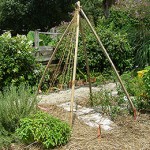
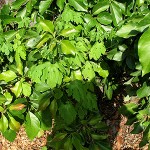

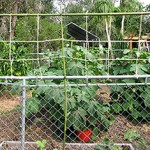
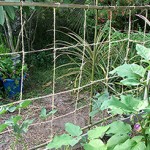
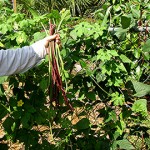
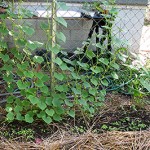

3 Responses
Thanks for discussing something I need help with (and never knew I did)!
You are always ‘in the garden’.
Good article. It’s the small things, like plant support, that make the biggest differences.
Thanks.
Thanks for your comments Sara and Daniel.